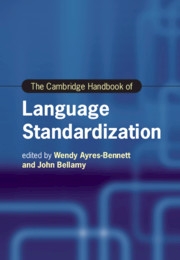Book contents
- The Cambridge Handbook of Language Standardization
- cambridge handbooks in language and linguistics
- The Cambridge Handbook of Language Standardization
- Copyright page
- Contents
- Figures
- Tables
- Contributors
- Introduction
- Part I Revisiting Models and Theories of Language Standardization
- Part II Legitimacy, Authority and the Written Form
- Part III Norms, Literacy and Education
- 14 Language Endangerment and Standardization
- 15 Indigenous Languages, Standardization and Curricular Development
- 16 Polynomic Standards
- 17 Standard Languages and Standardization in the Context of Bilingual Education
- 18 Setting Standards for Language Learning and Assessment in Educational Contexts
- Part IV Beyond the National
- Part V Standardization in Late Modernity
- Name Index
- Subject Index
- References
14 - Language Endangerment and Standardization
Perspectives from the Fourth World
from Part III - Norms, Literacy and Education
Published online by Cambridge University Press: 01 July 2021
- The Cambridge Handbook of Language Standardization
- cambridge handbooks in language and linguistics
- The Cambridge Handbook of Language Standardization
- Copyright page
- Contents
- Figures
- Tables
- Contributors
- Introduction
- Part I Revisiting Models and Theories of Language Standardization
- Part II Legitimacy, Authority and the Written Form
- Part III Norms, Literacy and Education
- 14 Language Endangerment and Standardization
- 15 Indigenous Languages, Standardization and Curricular Development
- 16 Polynomic Standards
- 17 Standard Languages and Standardization in the Context of Bilingual Education
- 18 Setting Standards for Language Learning and Assessment in Educational Contexts
- Part IV Beyond the National
- Part V Standardization in Late Modernity
- Name Index
- Subject Index
- References
Summary
A significant proportion of the threatened idioms of the world are small, pre-literate languages spoken by communities encapsulated within modern ‘developed’ countries (e.g. Canada, the USA, Australia and New Zealand) whose dominant population uses a European competitor language of great prestige and wide currency. This acute asymmetry has been referred to by some Canadian indigenous leaders as characterizing the ‘Fourth World’ languages. Growing concern about the future of these languages has led to a focus on developing indigenous language literacy to prevent or even to reverse their loss. Focusing on the ‘standardization’ of the Innu language spoken in Quebec (Canada), this case study addresses the issue of whether standardization can actually foster literacy in the indigenous language and curtail (or even reverse) shift to the dominant language. The chapter discusses the process of orthographic standardization among the Innus as it unfolded in the past fifty years. It compares it with similar contexts across the world. A growing consensus emerges that standardization and literacy skills in indigenous languages cannot prevent language loss, and it is doubtful that it can foster the revitalization of the receding language.
Keywords
- Type
- Chapter
- Information
- The Cambridge Handbook of Language Standardization , pp. 397 - 420Publisher: Cambridge University PressPrint publication year: 2021

